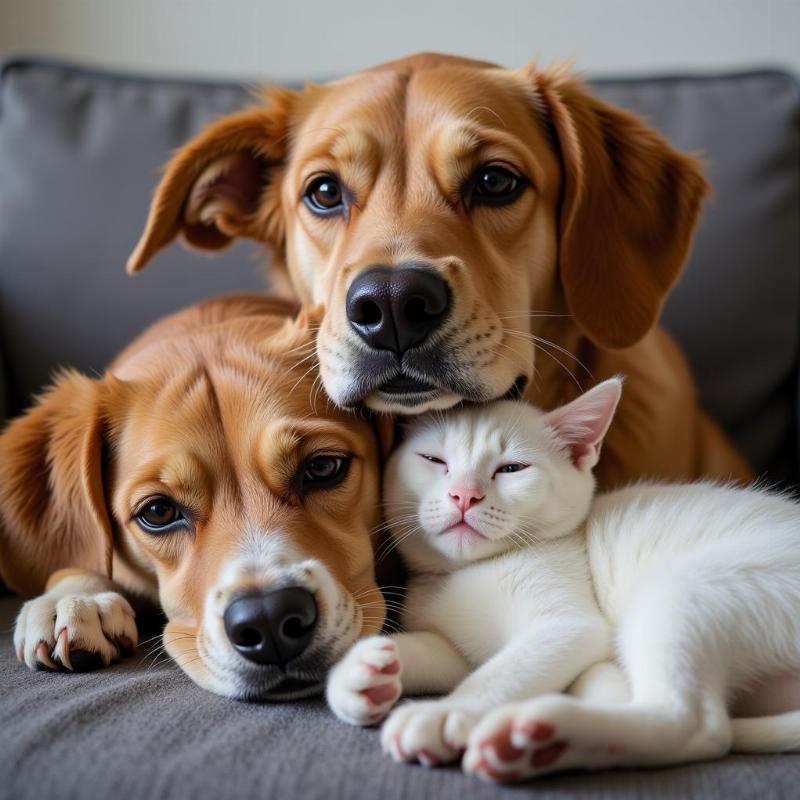Dogs and cats, two of the most beloved pets in American households, are often portrayed as sworn enemies. While their personalities and preferred methods of showing affection can differ greatly, they share surprising similarities that contribute to their unique charm. Understanding these commonalities can help pet owners appreciate both species and even foster harmonious cohabitation.
Shared Sensory Experiences: How Dogs and Cats Perceive the World
Both dogs and cats experience the world through heightened senses, albeit with different focuses. While dogs rely heavily on their incredible sense of smell, surpassing even the most advanced detection technology, cats excel in low-light vision and possess an acute sense of hearing. This allows them to navigate their surroundings with remarkable precision. They both also have sensitive whiskers that act as navigational tools, helping them gauge spatial awareness, especially in tight spaces.
The Social Lives of Dogs and Cats: More Alike Than You Think
Despite the stereotype of the independent cat and the pack-oriented dog, both species are capable of forming strong social bonds. Dogs, known for their exuberant greetings and pack mentality, thrive in social environments and often display clear signs of separation anxiety when left alone. Cats, though often perceived as solitary creatures, can develop deep attachments to their human companions and even other animals in the household. This is often manifested through gentle head rubs, purring, and playful interactions.
 Dogs and cats can form close bonds.
Dogs and cats can form close bonds.
Communicating with Your Furry Friends: Understanding Canine and Feline Language
While their methods of communication differ, dogs and cats express their needs and emotions through a combination of vocalizations and body language. Dogs use a variety of barks, whines, and growls to convey different messages, while cats communicate through meows, purrs, and hisses. Both species also rely heavily on body language, using tail wags, ear positions, and facial expressions to signal their mood and intentions. Understanding these subtle cues can strengthen the bond between pet and owner.
Nutritional Needs and Grooming Habits: Caring for Your Canine and Feline Companions
Both dogs and cats require a balanced diet to maintain their health and well-being, though the specific nutritional requirements vary depending on the species, age, and activity level. High-quality commercial pet food formulated for their specific needs is readily available throughout the US, offering a convenient way to ensure they receive the necessary nutrients. Both species also benefit from regular grooming to maintain a healthy coat and prevent matting. While dogs may require more frequent baths, cats excel at self-grooming but still appreciate occasional brushing, especially long-haired breeds.
Do Dogs and Cats Dream? Unraveling the Mysteries of Pet Sleep
Just like humans, both dogs and cats experience different stages of sleep, including REM sleep, the phase associated with dreaming. While we can’t know for certain what they dream about, their twitching paws and soft vocalizations during sleep suggest they may be reliving their daily adventures, chasing squirrels or batting at dangling toys. Providing a comfortable and safe sleeping environment is essential for their physical and mental well-being.
Conclusion: Celebrating the Unique Bond Between Humans and Their Pets
Despite their differences, the similarities between dogs and cats highlight the fundamental ways in which they enrich our lives. Their capacity for affection, their unique personalities, and their reliance on us for care create a bond that transcends species. Understanding their shared traits allows us to appreciate their individuality and provide the best possible care for these beloved members of our families. By recognizing the similarities between dogs and cats, we can foster a deeper appreciation for the unique contributions each species brings to our lives.
FAQ
- Do dogs and cats need the same vaccinations? No, dogs and cats require different vaccinations based on their species-specific vulnerabilities. Consult your veterinarian for a tailored vaccination schedule.
- Can dogs and cats live together peacefully? Yes, with proper introductions and socialization, dogs and cats can coexist harmoniously, even forming close bonds.
- Do dogs and cats understand human language? While they may not understand the literal meaning of words, dogs and cats are adept at interpreting tone of voice and body language.
- How can I tell if my dog or cat is sick? Changes in appetite, behavior, or grooming habits can indicate illness. Consult your veterinarian if you notice any concerning changes.
- What are the benefits of spay/neutering my pet? Spaying or neutering your pet helps prevent unwanted litters, reduces the risk of certain cancers, and can improve behavior.
- How can I choose the right food for my pet? Consult your veterinarian or a qualified pet nutritionist to determine the best diet for your pet’s specific needs.
- How often should I groom my pet? Grooming frequency varies depending on breed and coat type. Consult your veterinarian or a professional groomer for recommendations.
Beautdogs.us is your one-stop shop for all things dog-related in the US! We offer expert advice on dog breeds, care, and the best products for your furry friend. Whether you’re a seasoned dog owner or just starting out, Beautdogs.us is your trusted source for reliable information. Contact us today for personalized guidance! Email: [email protected], Phone: +1 501-555-7529. Visit Beautdogs.us for more expert tips and resources.